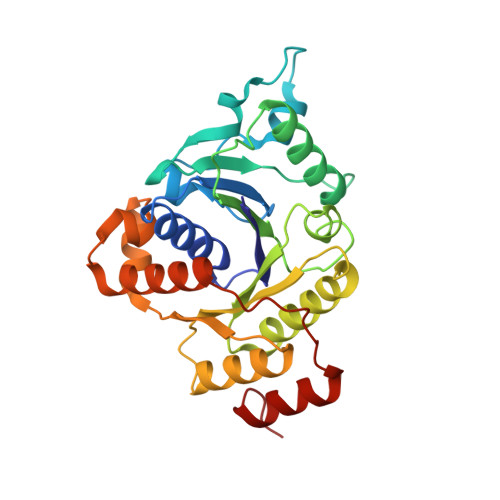Structural Analysis of a Nitrogenase Iron Protein from Methanosarcina acetivorans: Implications for CO 2 Capture by a Surface-Exposed [Fe 4 S 4 ] Cluster.
Rettberg, L.A., Kang, W., Stiebritz, M.T., Hiller, C.J., Lee, C.C., Liedtke, J., Ribbe, M.W., Hu, Y.(2019) mBio 10
- PubMed: 31289188
- DOI: https://doi.org/10.1128/mBio.01497-19
- Primary Citation of Related Structures:
6NZJ - PubMed Abstract:
Nitrogenase iron (Fe) proteins reduce CO 2 to CO and/or hydrocarbons under ambient conditions. Here, we report a 2.4-Å crystal structure of the Fe protein from Methanosarcina acetivorans ( Ma NifH), which is generated in the presence of a reductant, dithionite, and an alternative CO 2 source, bicarbonate. Structural analysis of this methanogen Fe protein species suggests that CO 2 is possibly captured in an unactivated, linear conformation near the [Fe 4 S 4 ] cluster of Ma NifH by a conserved arginine (Arg) pair in a concerted and, possibly, asymmetric manner. Density functional theory calculations and mutational analyses provide further support for the capture of CO 2 on Ma NifH while suggesting a possible role of Arg in the initial coordination of CO 2 via hydrogen bonding and electrostatic interactions. These results provide a useful framework for further mechanistic investigations of CO 2 activation by a surface-exposed [Fe 4 S 4 ] cluster, which may facilitate future development of FeS catalysts for ambient conversion of CO 2 into valuable chemical commodities. IMPORTANCE This work reports the crystal structure of a previously uncharacterized Fe protein from a methanogenic organism, which provides important insights into the structural properties of the less-characterized, yet highly interesting archaeal nitrogenase enzymes. Moreover, the structure-derived implications for CO 2 capture by a surface-exposed [Fe 4 S 4 ] cluster point to the possibility of developing novel strategies for CO 2 sequestration while providing the initial insights into the unique mechanism of FeS-based CO 2 activation.
- Department of Molecular Biology and Biochemistry, University of California, Irvine, California, USA.
Organizational Affiliation:


















